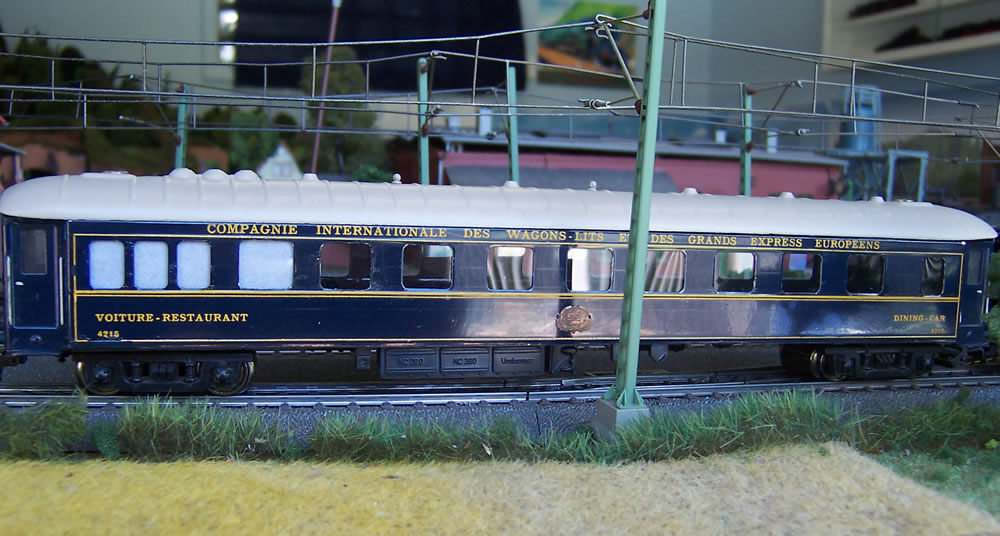HO scale models of Nord Express
The Nord Express was inaugurated in 1896 and formed part of the CIWL network
in Europe. It ran from Paris to Stockholm, with branches to Warsaw and St
Petersburg. In Paris there was a connecting service to the Sud Express (Southern
Express) to Lisbon. The exact routes possibly varied, according to the season.
After World War II, the Nord Express, and its parallel train, the Scandinavian
Express, utilized cars from the co-operating railway systems, as well as their
own wagon-lits (sleepers) and WR cars (restaurants).
It appears from below (a 1948 film), that the origins and destinations differed on each car, depending on its point of embarkation. Some cars started at Basle, some started at Ostende, some finished at Stockholm, some at Copenhagen.
Coach labels from the film show:
1. Basel SBB-Frankfurt-Hamburg-Kobenhavn-Stockholm
2. Kobenhavn-Hamburg-Bremen-(Kol?)n-Bruxelles-Oostende-(London)


Background to a set of models for 1948
I can use Orient Express cars from my 1946 and 1959 boxed sets, and augment them with cars specifically collected for the Nord Express. To retain some uniformity with those sets, I collect models made of sheet metal, and invariably these will be models from a past era. I will add new acquisitions to this page as I locate them. This is in spite of the availability of many plastic model coaches of this type, from Rivarossi, LS Models and Jouef.
The composition of this train in 1948, can be partly defined by a 1948 film
produced by the DSB.
https://www.youtube.com/watch?v=AGs67NDyBZE
Locomotive DSB Litra E #971-ex Nord SNCF baggage-ex Nord SNCF 2nd class
car-CIWL sleeper #3835-CIWL sleeper #3871 (last two figures unsure)-Hecht
type compartment car (DB or DSB?)-....
A restaurant car (WR) was attached. Timetables into the late 1950s, suggest
the WR car ran to and from Nyborg (Denmark) - Osnabruck (central Germany).
Full details of a 1958 plan and timetable of this train are available at a
1958
railway history site.
The models for 1948
#4215 restaurant car was built in Brussells in 1940, and was certain to have run between Paris and Stockholm after the cessation of war in 1945.
This model by PMP (Pierre Marie Pillon) catalogue #531, was built in Paris sometime in the 1950s. It is a very fine model, 26.5cm long, but this example would be classed as 5/10 on scale of originality and condition. It has replacement bogies, and a screw-on underframe has been modelled in plastic. The roof has been repainted. I have seen three different side window arrangements on other examples of this model. Construction details of this model.

Here is a photo of a set of PMP models I have collected to represent the Nord
Express in 1948. The SNCF cars are the OCEM variants, whereas information
available indicates that ex-Nord cars would most likely have been used. Ex-Nord
SNCF models are available from the PMP brand, but do not often show up for
sale.
PMP Models with catalogue number are, from top:
Catalogue 533 - Wagon Lits 2nd class #3905
531 - Restaurante #4215
501 - SNCF, Couchette A12/2 c 12/2 myfi – #578
505 - SNCF, D d2 58911, Fourgon interdit aux voyageurs

The passenger cars in this set are made of sheet metal in three pieces: the
roof, the body and chassis. (Details here)
In addition, they are equipped with detail such as handrails, buffers, bellows,
and transparent or opaque glass, CIWL crests, and running boards. The first
PMP production cars had add-on roof aerators, but they were quickly integrated
into the roof pressings. Note the lack of underbody detail.
The silk screen process (or screen printing) decoration of the car body is
thin and very successful, and is done before folding. As was the case in these
times, the cars do not have interiors. Sleeper cars (in blue, catalogue #532,
533) and saloon cars (blue/cream, catalogue #541, 542 and brown/cream, catalogue
#551, 552) were built by PMP for their CIWL range.
History of PMP models
The PMP firm was founded in 1946 by Robert and Pierre-Marie Leplat PILLON, giving the latter’s initials to the small firm. It was situated in Boulevard Bineau in Neuilly sur Seine in France
In 1948 the firm turned definitively to the model railroad market. A small
train of the Paris metro in HO scale was the first production. It was followed
by a few engine types, including a rail car and steam tank engine. Other locomotives,
all manufactured of sheet, brass or bronze, were produced into the early 50s.
Besides the locomotives, PMP were notable for their great cars of a very high
quality. With sheet metal bodies 265mm long, the grande lignes passenger cars
were finely decorated using screen printing. From 1950 to 1953, PMP produced
the "NORD", "OCEM", and "PLM" cars, along with
beautiful cars of the "CIWL". The most common example was the OCEM
car.
PMP cars are generally easy to recognize thanks to the PMP logo underneath
the chassis. The first PMP coupler was a small loop similar to that used by
VB. That was replaced by the universal Märklin type shortly before the
closure of the small firm.
Fo this information, I would like to acknowledge the definitive work on French train models here: (http://www.lestrainsdeguillaume.com/default.php)
<<<<<<>>>>>>
This CIWL dining car is beautifully presented at the Danish
National Railway Museum, in Odense, Denmark. The car was used on the Nord
and Scandinavian Expresses well into the 1960s/70s.
The name of the car builder, Astra of Romania (1943), can be read on the top
step. The static model of the grey-coated gentleman represents a wheel-tapper.
It was his job to test for wheel degradation or cracking. The sound of the
hammer on the steel wheel tire proved it one way or another.

Orient Express models in a layout setting
Link to the history of the Orient Express.
The enjoyment of Maerklin trains index